It’s the sort
of work for which the phrase “tour de force” was coined. First, you
need a grandiose production using all the forces at your command (because
we’ll all know just what you don’t command if you don’t have
it here), and the Met had that — the much-loved Schenk-Schneider-Siemssen
production, now being retired. (Will they destroy it? Or stash it and bring it
back after a new one flops? Depends who’d have to pay the storage costs.)
Second, you need a conductor and an orchestra, and James Levine, who has led so
many Rings with the Met orchestra he so lovingly put together, is a
known Wagnerian quantity. But even his experience cannot account for the
lightness of touch, the ease with which the whole ponderous juggernaut glided,
took flight, zipped seamlessly by, on the present occasion. Even the horns
seemed to be enjoying themselves.
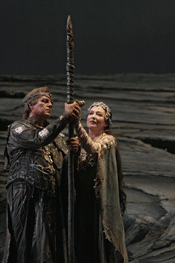 Albert Dohmen as Wotan and Yvonne Naef as Fricka [Photo by Beatriz Schiller courtesy of The Metropolitan Opera]
Albert Dohmen as Wotan and Yvonne Naef as Fricka [Photo by Beatriz Schiller courtesy of The Metropolitan Opera]
Third, you need a cast, especially a Wotan, a Brunnhilde, a Siegfried
— though I’m with Wagner: there are no small parts. (The
Rhinemaidens and Norns in this Ring proved that quite well.) Rather to
my surprise, this was one of the best Rings for all-around singing of
recent decades, even if it lacked the superlative Brunnhilde and Siegfried we
all sigh for. First, the Wotan — Albert Dohmen, who has sung Wotan at
Bayreuth, Vienna, Berlin and places like that, took over the part for, we
assumed, a first essay to succeed the aging James Morris’s well-known
interpretation. Who remembers how incredulous everyone was when Morris, a bel
canto and Mozart specialist, first took it on? I do — in San Francisco,
1985 — and how excited we all were by the beauty of his way of doing
things. Now, he seems to have been doing it forever, and I was foolishly
surprised that Dohmen gave us so mature, so satisfying Wotan, different but
equal. Dohmen’s singing of the part was audibly nastier and less sane
than Morris’s bel canto shimmer, but full-voiced and thrilling —
his own version, and a clear one. (And the loudest Wanderer I’ve ever
heard.)
For the second cycle, erstwhile mezzo-soprano Katarina Dalayman sang the
Br¸nnhildes of Die Walk¸re and Gˆtterd‰mmerung, with far
better command of the soprano tessitura than her Isolde demonstrated last
winter, lovely bursts of warm sound, spectacular power in moments of high
emotion, and a genuine trill in Act II of Gˆtterd‰mmerung —
besides looking rather fetching in those oddly-hemmed buckskin shmattas.
(During the first season of this production, a friend whispered, “Barbara
Mandrell would kill for that outfit.”) Unfortunately, Linda Watson sang
the higher Br¸nnhilde of Siegfried with a shriek that blistered the
pine trees — when she opened her mouth, you never knew what would come
out, but very little of it gave pleasure. At that, a Ring with only
half an act where you cringe is a pretty impressive Ring, and the
previous two and a half acts may have been the best Siegfried of my
experience of that least loved work of the tetralogy.
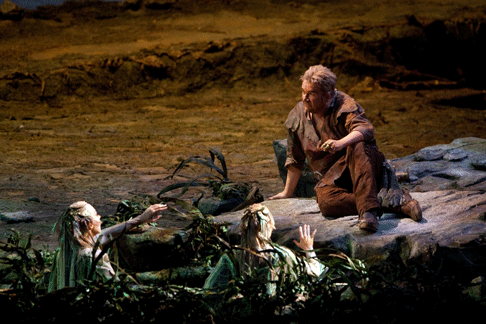 Christian Franz as Siegfried and the Norns [Photo by Marty Sohl/Metropolitan Opera]
Christian Franz as Siegfried and the Norns [Photo by Marty Sohl/Metropolitan Opera]
Siegfried was sung by Christian Franz. He does not have the ideal physique
for the role (he was shorter than Alberich) nor the ideal, tireless voice, but
he is a talented, intelligent performer — his playing of the naÔve,
good-natured hero was charming, bumptious, in perfect character — I
especially enjoyed his “Hey-I’m-here-too” wave at
newly-wakened Brunnhilde, as she ignored him to salute the sun. He seemed
tickled just to be Siegfried, and to be living Siegfried’s life —
which is the figure Wagner wanted. And his skill when his voice audibly ran out
of steam, at speaking or half-singing certain lines effectively, never left us
in doubt that we would have a performance, whatever happened. It was very
professional work, and in his better-rested scenes, musical as well.
Among the other excellent performers, top marks go to Yvonne Naef’s
regal Fricka and, even more, her desperate, impassioned Waltraute (has one seen
so intense a Waltraute? Even Troyanos?). It was a pleasure to hear the Nibelung
brothers sing their music, instead of the usual whine and croak, and
singing is what we got, with no loss of drama, from Richard Paul Fink’s
nasty, gnome Alberich, and from Tom Fox, who took over the part in
Siegfried, and also, top honors, Robert Brubaker’s fluttery,
adorably creepy Mime. Rheingold also gave us Kim Begley’s fine,
sleazy Loge and the underutilized Charles Taylor as a princely Donner —
who ever notices Donner? Well, everyone noticed, and heard, this one, swinging
his hammer like an Olympic athlete and tossing his voice about with similar
power. RenÈ Pape sang a lovable Fasolt and a bitter Hunding; Iain Paterson a
good Gunther; Margaret Jane Wray a stalwart Gutrune (but is the Met ever going
to employ her as anything else? I’ve heard her splendid
Sieglinde, but only in Seattle). John Tomlinson, who has been singing Wagner
leads even longer than James Morris, was in total control of Fafner’s
heavy lines, but also made a memorable Hagen — I’ve never seen
that dour part done with such glee, as such a merry old elf —
you thought he was going to put Siegfried on his knee and ask him what he
wanted for Yule — and then not give it to him. Like Franz, he
sometimes shouted lines he can no longer sing mellifluously, but he’s an
actor, he made it work for him, and it’s somehow even more horrible to
have Mr. Jolly stab the hero in the back than the usual grim hit man.
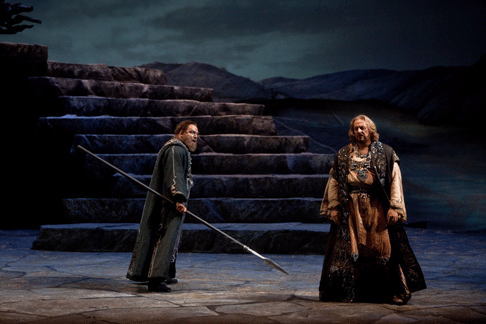 John Tomlinson as Hagen and Iain Paterson as Gunther [Photo by Marty Sohl/Metropolitan Opera]
John Tomlinson as Hagen and Iain Paterson as Gunther [Photo by Marty Sohl/Metropolitan Opera]
From the many ladies in supporting roles, one might single out Kate Lindsay
among the Rhinemaidens and Wendy Bryn Harmer as the soprano Norn, but these
were standouts in absurdly good trios. The valkyries were fun, too — and
hardly louder.
Slightly less deserving of the highest praise, but still worthy of a great
Ring in a great opera house, were Wendy White’s pleasing but not
deeply compelling Erda (in a costume that made her look like Amneris in a 1900
production of Aida) and Adrianne Pieczonka’s Sieglinde —
beautifully acted and, on the whole, sung, but her lovely voice weakens on top,
turning a bit white at moments of excitement, and there were gleams of wobble
in her narration.
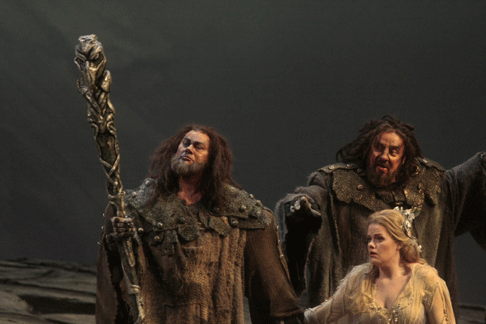 RenÈ Pape as Fasolt, John Tomlinson as Fafner and Wendy Bryn Harmer as Freia [Photo by Beatriz Schiller/MetropolitanOpera]
RenÈ Pape as Fasolt, John Tomlinson as Fafner and Wendy Bryn Harmer as Freia [Photo by Beatriz Schiller/MetropolitanOpera]
Pl·cido Domingo cannot persuade the Met to lower Siegmund’s music a
tone, as he often does in Italian roles, and his German sounds a bit like
Spanish, but he did get through it — partly, it seemed, by rushing when
he was short on breath, obliging his old friend Maestro Levine to hurry the
pace as well. Yes, he’s a miracle, and he plays this life-battered hero
well, but it might be time to call it a career, at least as a Wagner tenor.
(Has anyone noticed that that ghastly painting of him in “Roman”
costume at the top of the grand staircase, all shoulderpads and helmet,
resembles an ice hockey goalkeeper?)
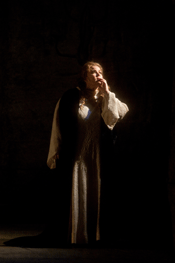 Margaret Jane Wray as Gutrune [Photo by Marty Sohl/Metropolitan Opera]
Margaret Jane Wray as Gutrune [Photo by Marty Sohl/Metropolitan Opera]
The only singers really not worthy of a great Ring were Watson and
the tenor playing Froh. When did you last attend a Ring where only
Froh and the last twenty minutes of Siegfried made you wince? This was
a joyous and memorable week, with too many exquisite moments to enumerate, too
many times Wagner and his interpreters seemed to be doing everything right,
when you didn’t want to be anyplace else on earth.
There is no one way to stage any opera, and the Ring offers more
interpretative opportunities than most, than almost any. You can be literal
— but that’s not done much any more. You can be mythic or ethnic or
archetypal or economic or historicist or very very dark (I have seen all these
done) or you can impose your own artistic mÈthode on the matter (as
Robert Wilson did in Zurich lately) or deconstruct the thing (as in Weimar last
month) or do it in concert. The winged helmets and ladies in steel exoskeletons
that were so novel in Wagner’s day are now a deathless clichÈ — the
Met brought them back for its recent 125th anniversary gala, arguing — as
can hardly be doubted — that almost no one going to the opera today has
ever seen such things, and that everyone would be thrilled to do so, at least
once. Actually, that’s not quite true — we’ve all seen ladies
in winged helmets and hubcab brassieres — but we’ve seen them in
automobile commercials, satirical skits, comic books, in parodies like Gilbert
and Sullivan’s Iolanthe or as a walk-on in The Ghosts of
Versailles — few people have seen such things in an actual
Ring.
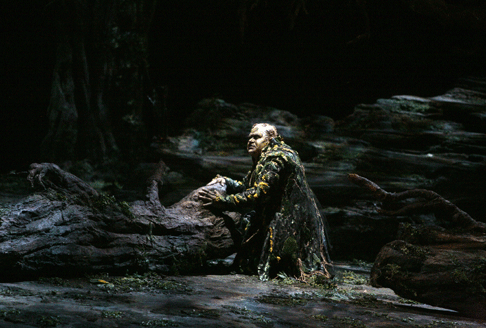 Richard Paul Fink as Alberich [Photo by Beatriz Schiller/Metropolitan Opera]
Richard Paul Fink as Alberich [Photo by Beatriz Schiller/Metropolitan Opera]
This is a major reason why the Met first decided to do an old-fashioned
scenic Ring — because no one else does it that way any more
(least of all Bayreuth, or anywhere else in Germany), and their judgment was
sound. Every Wagnerian the world over (and that’s a lot of people) would
love to see it done that way, just once (some of them would like to see it that
way every time), and the fact that the Met does three cycles every three years
(as has been the custom since this production was inaugurated, twenty years
ago) is a great lure. This year, I ran into visitors who’d come from
Melbourne and Budapest and Hong Kong and Zurich; I overheard conversations in
Russian and German and French and Italian, and several languages I don’t
know. There is an audience for the fairy tale treatment — whereas, if
it’s motorcycle helmets, and ladies in fishnet stockings and spike heels,
and gods (or Norns) reading the newspaper, and Alberich beating off in a trench
coat, and a mechanical dragon — we’ve all seen that. We’ve
seen it, seen it, seen it. It’s a damned boring way to do opera —
the way everyone else does it now.
The Met’s old-fashioned productions are a major tourist draw. They
make the Met stand out as its repertory and singing roster no longer do. And
the audience they draw is very broad. A woman said to me that she felt quite
young at this Ring — she was my age, which is not young —
because so many far older folk were there. And there were. But the house was
also packed with young people, kids brought by parents, 20-somethings and
30-somethings, on dates or showing off elegant new clothes or seeing that real
music-lovers don’t always need to wear elegant clothes to go to
the opera, and they were really grooving on it. Is this a Tolkien movie spinoff
crowd? Or young people sick of CGI and sampled beats who want to hear real
voices and real instruments, unfiltered by electronics for once? No idea, I
didn’t ask, but it’s a fine sight at the Met, where these
youngsters are imbibing the lesson that opera can be a thrill, and the Met is
not a forbidding place to go. The Gelb administration gets much kudos for
drawing them in, by whatever means: the Wagnerians of the future.
John Yohalem
image=http://www.operatoday.com/Dalayman_Brunnhilde.gif
image_description=Katarina Dalayman as Br¸nnhilde [Photo: Marty Sohl/Metropolitan Opera]
product=yes
product_title=Richard Wagner: Der Ring des Nibelungen
product_by=Wotan: Albert Dohmen; Fricka and Waltraute: Yvonne Naef; Alberich: Richard Paul Fink/Tom Fox; Loge: Kim Begley; Erda: Wendy White; Donner: Charles Taylor; Fasolt and Hunding: RenÈ Pape; Fafner and Hagen: John Tomlinson; Mime: Dennis Petersen/Robert Brubaker; Br¸nnhilde: Katarina Dalayman/Linda Watson; Siegmund: Pl·cido Domingo; Sieglinde: Adrianne Pieczonka; Siegfried: Christian Franz; Forest Bird: Lisette Oropesa; Gunther: Iain Peterson; Gutrune: Margaret Jane Wray. Metropolitan Opera, conducted by James Levine, performances of April 27, 28, 30 and May 2.
product_id=Above: Katarina Dalayman as Br¸nnhilde [Photo: Marty Sohl/Metropolitan Opera]